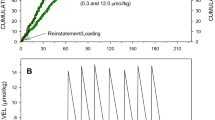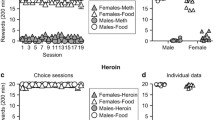Abstract
Heroin self-administration behavior under a progressive ratio (PR) schedule of reinforcement was evaluated in rats. The schedule was designed to restrict drug intake, minimize opiate dependency, and quantify the number of responses emitted (final response ratio) in order to receive a limited number of heroin infusions. Final ratios were found to be stable and did not increase with chronic (31 days) PR reinforcement. The ability of the PR schedule to detect changes in heroin reinforcement was demonstrated by evaluating the effect of naltrexone pretreatment and unit dose alteration on final ratios. Naltrexone (0.4 mg/kg) reduced final ratios and an inverted U dose-response relationship was established for the unit heroin doses 12.5–100 µg/injection. Maximal final ratios occurred with 50 µg/injection heroin reinforcement. This PR schedule may provide a useful method for evaluating the effects of pharmacological manipulations or lesions on opiate reinforcement.
Similar content being viewed by others
References
Corrigall WA (1987) Heroin self-administration: effects of antagonist treatment in lateral hypothalamus. Pharmacol Biochem Behav 27:693–701
Corrigall WA, Vaccarino FJ (1988) Antagonist treatment in nucleus accumbens or periaqueductal grey affects heroin self-administration. Pharmacol Biochem Behav 30:443–450
Dai S, Corrigall WA, Coen KM, Kalant H (1989) Heroin self-administration by rats: influence of dose and physical dependence. Pharmacol Biochem Behav 32:1009–1015
Ettenberg A, Pettit HO, Bloom FE, Koob GF (1982) Heroin and cocaine intravenous self-administration in rats: mediation by separate neural systems. Psychopharmacology 78:204–209
Goldberg SR, Woods JH, Schuster CR (1971) Nalorphine-induced changes in morphine self-administration in rhesus monkeys. J Pharmacol Exp Ther 176:464–471
Griffiths RR, Findley JD, Brady JV, Gutcher L, Robinson WW (1975) Comparison of progressive-ratio performance maintained by cocaine, methylphenidate, and secobarbitol. Psychopharmacology 43:81–83
Griffiths RR, Brady JV, Snell JD (1978) Progressive-ratio performance maintained by drug infusions: comparison of cocaine, diethylpropion, cholphentermine, and fenfluramine. Psychopharmacology 56:5–13
Griffiths RR, Bradford LD, Brady JV (1979) Progressive ratio and fixed ratio schedules of cocaine-maintained responding in baboons. Psychopharmacology 65:125–136
Hodos W (1961) Progressive ratio as a measure of reward strength. Science 134:943–944
Hoffmeister F (1979) Progressive-ratio performance in the rhesus monkey maintained by opiate infusions. Psychopharmacology 62:181–186
Hubner CB, Koob GF (1990) The ventral pallidum plays a role in mediating cocaine and heroin self-administration in the rat. Brain Res 508:20–29
Killian A, Bonese KF, Schuster CR (1978) The effects of naloxone on behavior maintained by cocaine and heroin injections in the rhesus monkey. Drug Alcohol Depend 3:243–251
Koob GF, Pettit HO, Ettenberg A, Bloom FE (1984) Effects of opiate antagonists and their quaternary derivatives on heroin self-administration in the rat. J Pharmacol Exp Ther 229:481–486
Loh EA, Roberts DCS (1990) Break-points on a progressive ratio schedule reinforced by intravenous cocaine increase following depletion of forebrain serotonin. Psychopharmacology 101:262–266
Risner ME, Cone EJ (1986) Intravenous self-administration of fencamfamine and cocaine by beagle dogs under fixed-ratio and progressive-ratio schedules of reinforcement. Drug Alcohol Depend 17:93–102
Risner ME, Goldberg SR (1983) A comparison of nicotine and cocaine self-administration in the dog: fixed ratio and progressive-ratio schedules of intravenous drug infusion. J Pharmacol Exp Ther 224:319–326
Risner ME, Silcox DL (1981) Psychostimulant self-administration by beagle dogs in a progressive-ratio paradigm. Psychopharmacology 75:25–30
Roberts DCS, Goeders N (1989) Drug self-administration: experimental methods and determinants. In: Boulton AA, Baker GB, Greenshaw AJ (eds) Neuromethods: psychopharmacology vol 13. Humana, Clifton, NJ, pp 349–398
Roberts DCS, Bennett SAL, Vickers GJ (1989a) The estrous cycle affects cocaine self-administration on a progressive ratio schedule in rats. Psychopharmacology 98:408–411
Roberts DCS, Loh EA, Vickers GJ (1989b) Self-administration of cocaine on a progressive ratio schedule in rats: dose-response relationship and effect of haloperidol pretreatment. Psychopharmacology 97:535–538
Weeks JR, Collins RJ (1987) Screening for drug reinforcement using intravenous self-administration in the rat. In: Bozarth, MA (ed) Methods of assessing the reinforcing properties of abused drugs. Springer, Berlin Heidelberg New York, pp 35–43
Author information
Authors and Affiliations
Rights and permissions
About this article
Cite this article
Roberts, D.C.S., Bennett, S.A.L. Heroin self-administration in rats under a progressive ratio schedule of reinforcement. Psychopharmacology 111, 215–218 (1993). https://doi.org/10.1007/BF02245526
Received:
Revised:
Issue Date:
DOI: https://doi.org/10.1007/BF02245526




